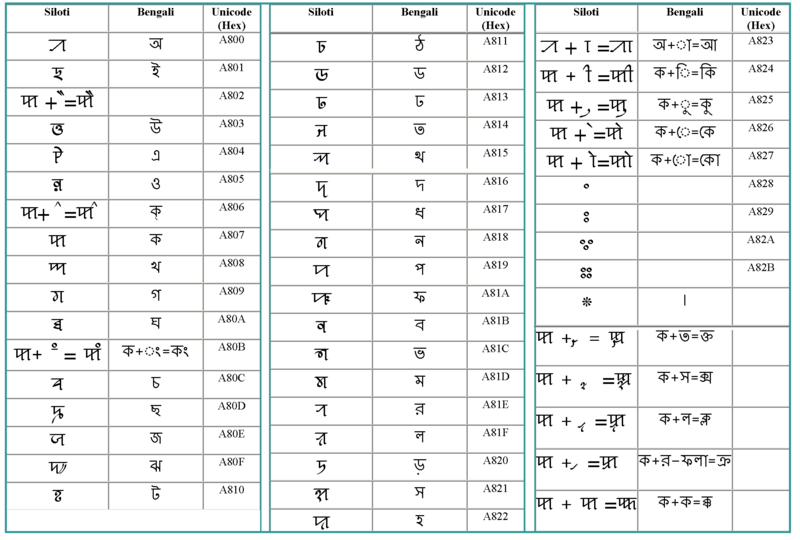Sylheti Nagari
| Sylheti Nagari Silôṭi Nagri ꠍꠤꠟꠐꠤ ꠘꠣꠉꠞꠤ | |
|---|---|
 | |
| Type | |
| Languages | Sylheti, Bengali |
Time period | 14th-20th Century |
| Direction | Left-to-right |
| ISO 15924 |
Sylo, 316 |
Unicode alias | Syloti Nagri |
| U+A800–U+A82F | |
Sylheti Nagari or Jalalabadi Nagri (Silôṭi Nagôri) is one of the many scripts used for writing the Sylheti language. It is an almost extinct script, this is because of development of Bengali scripts, more after Bangladesh gained independence and because it did not make sense for a dialect to have its own script, its use was heavily discouraged. The government of the newly formed Bangladesh did so to promote a greater "Bengali" identity. This led to the informal adoption of the Eastern Nagari script also used for Bengali and Assamese. Sylheti Nagari is also known as Jalalabadi Nagri, Mosolmani Nagri, Ful Nagri etc.
Sylheti symbols

Vowels
- 5 independent vowels
- 5 dependent vowel signs attached to a consonant letter
Consonants
- 27 consonants
Sample Text

Unicode
Sylheti Nagari was added to the Unicode Standard in March, 2005 with the release of version 4.1.
The Unicode block for Sylheti Nagari is U+A800–U+A82F:
| Syloti Nagri[1][2] Official Unicode Consortium code chart (PDF) | ||||||||||||||||
| 0 | 1 | 2 | 3 | 4 | 5 | 6 | 7 | 8 | 9 | A | B | C | D | E | F | |
| U+A80x | ꠀ | ꠁ | ꠂ | ꠃ | ꠄ | ꠅ | ꠆ | ꠇ | ꠈ | ꠉ | ꠊ | ꠋ | ꠌ | ꠍ | ꠎ | ꠏ |
| U+A81x | ꠐ | ꠑ | ꠒ | ꠓ | ꠔ | ꠕ | ꠖ | ꠗ | ꠘ | ꠙ | ꠚ | ꠛ | ꠜ | ꠝ | ꠞ | ꠟ |
| U+A82x | ꠠ | ꠡ | ꠢ | ꠣ | ꠤ | ꠥ | ꠦ | ꠧ | ꠨ | ꠩ | ꠪ | ꠫ | ||||
| Notes | ||||||||||||||||
References
External links
- A full archive
- Omniglot
- Islam, Muhammad Ashraful (2012). "Sylheti Nagri". In Islam, Sirajul; Jamal, Ahmed A. Banglapedia: National Encyclopedia of Bangladesh (Second ed.). Asiatic Society of Bangladesh.